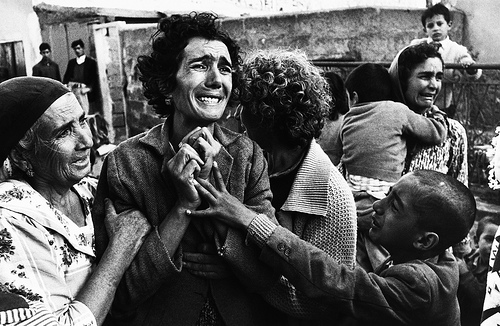- Juxtaposition - This is a photograph having recognition, meaning and showing excellent attention to detail.
- Decisive Moment - Showing a great awareness of visual observation, taking the photograph at exactly the right time, as if taken seconds before or seconds after would not be as successfully composed or be profound in extreme juxtaposition! One of the most famous photographers known world wide in regards to taking photographs using the 'Decisive Moment' is Henri Cartier Bresson

- Behind the Gare St. Lazare, Paris - "There was a plank fence around some repairs behind the Gare Saint-Lazare train station. I happened to be peeking through a gap in the fence with my camera at the moment the man jumped." This is the world's most famous photograph which depicts 'The Decisive Moment' at its very best
- Visual Irony - Employing a humorous reference
- Viewer Recognition - A human or living creature being aware that the photograph is being taken
- Supreme Composition - A multitude of lines, shapes forms and patterns to create a excelling artistic and aesthetically pleasing supreme composition
- Symbol Inclusion - Sign's and written references placed carefully within the framing of the photograph to aid key qualities above
What is photojournalism? Occasionally, a very unique photo, in which form is precise and rich enough and content has enough resonance, is sufficient in itself - but that's rarely the case. The elements of a subject that speak to us are often scattered and can't be captured in one photo; we don't have the right to force them together, and to stage them would be cheating... which brings us to the need for photojournalism. - Henri Cartier-Bresson - "American Photo", September/October 1997, page: 76
The camera enables us to keep a kind of visual record. We photo-reporters are people who supply information to a world in haste and swamped, willy-nilly, in a morass of printed matter. This abbreviation of the statement which is the language of photography is very potent; we express, in effect, an adjudgment of what we see, and this demands intellectual honesty. We work in terms of reality, not of fiction, and must therefore “discover”, not fabricate. - Henri Cartier-Bresson - February 22, 1968., The World of Henri Cartier-Bresson by Henri Cartier-Bresson , ISBN: 0670786640
Henri-Cartier Bresson (1908-2004) Considered to be one of the world's most influential and modern photojournalists of the 20th Century and was 1 of 4 photographer's who formed the world's most prestigious photographic agencies called Magnum
Below are further images by Henri-Cartier Bresson which I find inspiring , his attention to detail and the sheer amount of patience needed to photograph the scene at precisely the correct time I find admirable

Hyères, France 1932

Madrid, 1933

Palais Royal, 1960

La danse Alloeng Kotjok, Sayan, Bali, Indonésie, 1949
To accomplish a truly decisive moment, which has become a common place within photojournalism, is for the photograph to describe a dramatic and also give an expressive visual climax, to show a story rather than just a picture. A great example of a genuine spontaneous news moment holding such strong compositional values is Don McCullin's photograph that won the World Press Photo award in 1964.

Cyprus 1964 - a Turkish woman mourns for her husband killed in a village battle with Greeks
Harold Evans - "Pictures On A Page - Photojournalism, Graphics and Picture Editing", 1978, page: 118
A truley renowned street photographer who has focussed a high majority of his work on America's social landscape from the 1950's is Lee Friedlander. His photographic art has a strange and unusual vision as he uses detached images of urban life, similarly how pop art works, to capture the feel and look of a modern society. His style usually incorporates store-front reflections, signs, posters and framed structures.
There are many hidden attributes to his photographs which in affect gives a delay of recognition to the viewer. Many of his images have a sense of visual irony, like some of the below images I have selected below.

Baltimore, 1968

New York, 1963

De De and Billie Pierce
New Orleans
1962
No comments:
Post a Comment